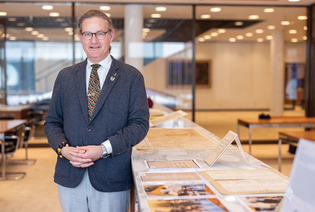
Allie Barton
Michael Morand ’87,’93MDiv, adores New Haven. Ask him a question about the city and its people, and he will instantly tell you where, when, and how.
View full image
Some 20 years ago, when I first started working at Yale, I sat down for a discussion with three or four others who worked at the university. One of them was a tall man with glasses and short blond hair, wearing a crisp white shirt, sharply creased gray trousers, and elegant brown leather shoes. He looked very somber. But he turned out to be a powerhouse with a heart of gold. He is Michael Morand ’87, ’93MDiv, now working as the director of community engagement at the Beinecke Library.
Over the years, Michael and I have had lunch together now and then. He seems to know almost everyone, good, bad, or iffy, and I’m always interested in hearing what he has to say. I visited him recently in the Beinecke Library, where he now has a large downstairs office and a gigantic window. Most people like to look downward from a high point; Michael has the glory of looking up into the sky, or looking straight across the marble platform to see the three works of marble—The Garden (Pyramid, Sun, and Cube)—sculpted by Isamu Noguchi.
I had two reasons for the visit. One was to talk about Michael’s work, along with the work of several others who had spent an enormous amount of time reading the Yale archives in order to trace the names, the labor, and the deaths of people who had been forced into slavery. The resulting book, Yale and Slavery, is both a phenomenal work and a lacerating read. But that said: everyone should read it. It’s free online to all (https://tinyurl.com/yaleandslaveryhistory). As James Baldwin declared, “History is not the past. It is the present. We are our history.”
My other reason for the visit was much more enjoyable. On April 11, the mayor of New Haven appointed Michael as city historian—a perfect choice, because Michael not only knows New Haven inside and out, but is also profoundly in love with the city. He reeled off to me several names of interesting businesses I’d never really thought about, or even known about: Alderman-Dow, a recycler that has been here for over a century. A. D. Perkins & Co., which can stamp almost anything, including signs of all kinds—from gleaming office nameplates to “SPEED LIMIT” warnings.
DelMonico Hatter, where you can buy a Kangol Ventair, an Authentic Wool Greek Fisherman Hat, and a Stetson Stratoliner Fur Felt Fedora. And of course, it goes without saying that New Haven has the best pizza in Connecticut. If not the nation.
I was also glad that as we were conversing, Michael tipped his hat to his predecessors who had held the office of city historian: “It’s an honor beyond measure to follow in the footsteps of Richard Hegel and Judy Schiff, who were extraordinary centurions of New Haven and its history,” he said. (I never knew Richard Hegel, but I worked with Judy on our “Old Yale” column for many years.)
He also told me that one of his main inspirations was John Warner Barber (1798–1885), whose engravings are beautiful, and who was one of only four people who had voted to start a Black college in New Haven. Moreover, in 1831 Barber published a book: The History and Antiquities of New Haven. But the most appealing part Michael told me about was this: Barber had heard that a traveler walking on East Rock had looked down on the Mill River, had seen the banks of the river—and had called it “the seat of happiness.”
Michael added: “That’s a place worth knowing. And it’s no surprise that this is a town people care fiercely about. There’s a lot of people who give a darn about the place. That’s expressed in nonprofit organizations, community associations, community memory groups, history groups—all kinds of ways.”
And one more note. At the Beinecke, Michael wasn’t wearing a crisp white shirt or creased gray trousers, but gentle orange, green, and yellow pastels—reminiscent of, say, a Hawaiian vacation—and I admired his new style. So let me leave you with a joke he cracked just before I left: “It is not possible to buy happiness. But you can buy pants.”
 loading
loading